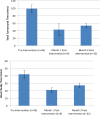Reducing Operating Room Turnover Time for Robotic Surgery Using a Motor Racing Pit Stop Model
- PMID: 28357497
- PMCID: PMC6010351
- DOI: 10.1007/s00268-017-3936-4
Reducing Operating Room Turnover Time for Robotic Surgery Using a Motor Racing Pit Stop Model
Abstract
Background: Operating room (OR) turnover time, time taken between one patient leaving the OR and the next entering, is an important determinant of OR utilization, a key value metric for hospital administrators. Surgical robots have increased the complexity and number of tasks required during an OR turnover, resulting in highly variable OR turnover times. We sought to streamline the turnover process and decrease robotic OR turnover times and increase efficiency.
Methods: Direct observation of 45 pre-intervention robotic OR turnovers was performed. Following a previously successful model for handoffs, we employed concepts from motor racing pit stops, including briefings, leadership, role definition, task allocation and task sequencing. Turnover task cards for staff were developed, and card assignments were distributed for each turnover. Forty-one cases were observed post-intervention.
Results: Average total OR turnover time was 99.2 min (95% CI 88.0-110.3) pre-intervention and 53.2 min (95% CI 48.0-58.5) at 3 months post-intervention. Average room ready time from when the patient exited the OR until the surgical technician was ready to receive the next patient was 42.2 min (95% CI 36.7-47.7) before the intervention, which reduced to 27.2 min at 3 months (95% CI 24.7-29.7) post-intervention (p < 0.0001).
Conclusions: Role definition, task allocation and sequencing, combined with a visual cue for ease-of-use, create efficient, and sustainable approaches to decreasing robotic OR turnover times. Broader system changes are needed to capitalize on that result. Pit stop and other high-risk industry models may inform approaches to the management of tasks and teams.
Conflict of interest statement
Figures
Similar articles
-
The Application of Human Factors Engineering to Reduce Operating Room Turnover in Robotic Surgery.World J Surg. 2022 Jun;46(6):1300-1307. doi: 10.1007/s00268-022-06487-z. Epub 2022 Feb 26. World J Surg. 2022. PMID: 35220451
-
Discovering the barriers to efficient robotic operating room turnover time: perceptions vs. reality.J Robot Surg. 2020 Oct;14(5):717-724. doi: 10.1007/s11701-020-01045-y. Epub 2020 Jan 13. J Robot Surg. 2020. PMID: 31933120
-
The efficiency of a dedicated staff on operating room turnover time in hand surgery.J Hand Surg Am. 2014 Jan;39(1):108-10. doi: 10.1016/j.jhsa.2013.09.039. Epub 2013 Nov 20. J Hand Surg Am. 2014. PMID: 24268833
-
Why can't we improve turnover time? A systematic review.World J Surg. 2024 Jan;48(1):72-85. doi: 10.1002/wjs.12015. Epub 2023 Dec 12. World J Surg. 2024. PMID: 38686762
-
Operating room efficiency.Semin Pediatr Surg. 2018 Apr;27(2):79-85. doi: 10.1053/j.sempedsurg.2018.02.004. Epub 2018 Feb 8. Semin Pediatr Surg. 2018. PMID: 29548356 Review.
Cited by
-
Surgical pit crew: initiative to optimise measurement and accountability for operating room turnover time.BMJ Health Care Inform. 2023 Jul;30(1):e100741. doi: 10.1136/bmjhci-2023-100741. BMJ Health Care Inform. 2023. PMID: 37451691 Free PMC article.
-
Preparatory Time-Related Hand Surgery Operating Room Inefficiency: A Systems Analysis.Hand (N Y). 2020 Sep;15(5):659-665. doi: 10.1177/1558944719831333. Epub 2019 Feb 27. Hand (N Y). 2020. PMID: 30808238 Free PMC article.
-
Barriers to safety and efficiency in robotic surgery docking.Surg Endosc. 2022 Jan;36(1):206-215. doi: 10.1007/s00464-020-08258-0. Epub 2021 Jan 19. Surg Endosc. 2022. PMID: 33469695 Free PMC article.
-
Personalized Alignment Strategies and the Need for Customization in Total Knee Arthroplasty: The Role of MISSO Joint Robotic System.J Orthop Case Rep. 2025 Aug;15(8):1-5. doi: 10.13107/jocr.2025.v15.i08.5862. J Orthop Case Rep. 2025. PMID: 40786758 Free PMC article. No abstract available.
-
Impact of a Task-Grabbing System for surgical technicians on operating room efficiency.Sci Rep. 2024 Feb 21;14(1):4296. doi: 10.1038/s41598-024-54524-9. Sci Rep. 2024. PMID: 38383755 Free PMC article.
References
-
- Cima RR, Brown MJ, Hebl JR, et al. Use of lean and six sigma methodology to improve operating room efficiency in a high-volume tertiary-care academic medical center. J Am Coll Surg. 2011;213:83–92. discussion 93-84. - PubMed
-
- Donham RTBM, Hebl JR, et al. Glossary of times used for scheduling and monitoring of diagnostic and therapeutic procedures. AORN journal. 1997;66:601–606. - PubMed
-
- Tyler DC, Pasquariello CA, Chen CH. Determining optimum operating room utilization. Anesthesia and analgesia. 2003;96:1114–1121. table of contents. - PubMed
-
- Rebuck DA, Zhao LC, Helfand BT, et al. Simple modifications in operating room processes to reduce the times and costs associated with robot-assisted laparoscopic radical prostatectomy. Journal of endourology / Endourological Society. 2011;25:955–960. - PubMed
-
- Urrego H, Sanni A, Toro JP, et al. Out by 3:30-A Study in Robotic Bariatric Surgery Efficiency. Bariatr Surg Pract P. 2014;9:55–60.
MeSH terms
Grants and funding
LinkOut - more resources
Full Text Sources
Other Literature Sources




